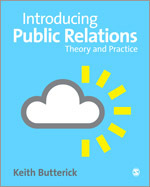Introducing Public Relations
Theory and Practice
- Keith Butterick - University of Huddersfield, UK
Political Communications | Public Relations (Analysis) | Public Relations (Practice)
With interviews and 'day in the life' examples from a wide range of professionals in the industry students will learn what PR practitioners do, what they think and how the industry really works. Putting the student first, this book:
- Gives a grounded, critical coverage of the history and theory of PR, so students understand not just the what but the how and why
- Covers all aspects of PR in practice, from in-house and consultancies to government, sport, NGO and corporate PR
- Packs each chapter with case studies, anecdotes from the field and career advice from expert PR professionals
- Helps easy revision with exercises, summaries and checklist.
Highly accessible and engaging, there is no better headstart to understanding what PR is all about. It is the perfect text for any students encountering public relations theory and practice for the first time.
A very well written book with great examples from the industry (mostly UK-based), including interviews with industry specialists. The author connects theory and practice very well and makes the PR job sound interesting and diverse.
This book is simple enough to be understood by 2nd year BA students. However, because it has many case studies from the UK, it is not 100% relevant to the PR industry of mainland Europe. (For example a case study on Cadbury's chocolate is difficult to follow, as this chocolate is not sold in Germany). I will hence put this book on the list of recommended supplemental reading.
This is an introductory book that assists students who are new to the field of public relations. By intertwining theory, concepts and models with case studies and practitioner quotations, first year students are encouraged to not only understand what public relations is but why and how the tools and tactics of public relations should be utilized.
Will be considered for next year as obligatory reading.
The book was adopted as main textbook last academic year. However, the content was found to be less organized and over simplified when compared to other textbook.
Strong industry contributions. Student friendly text makes PR and wider communication concepts easy to understand.
Lacked sufficient academic referencing/evidence base - largely practice orientated. Might suit Year 1 students.
A refreshing new approach for an introductory text to public relations theory and practice.
Accessible and engaging introduction.
This book is useful to provide a basic and practically oriented overview of the field at the undergraduate level.
For a quick readable overview of the field, this new book is hard to beat.


